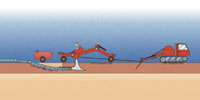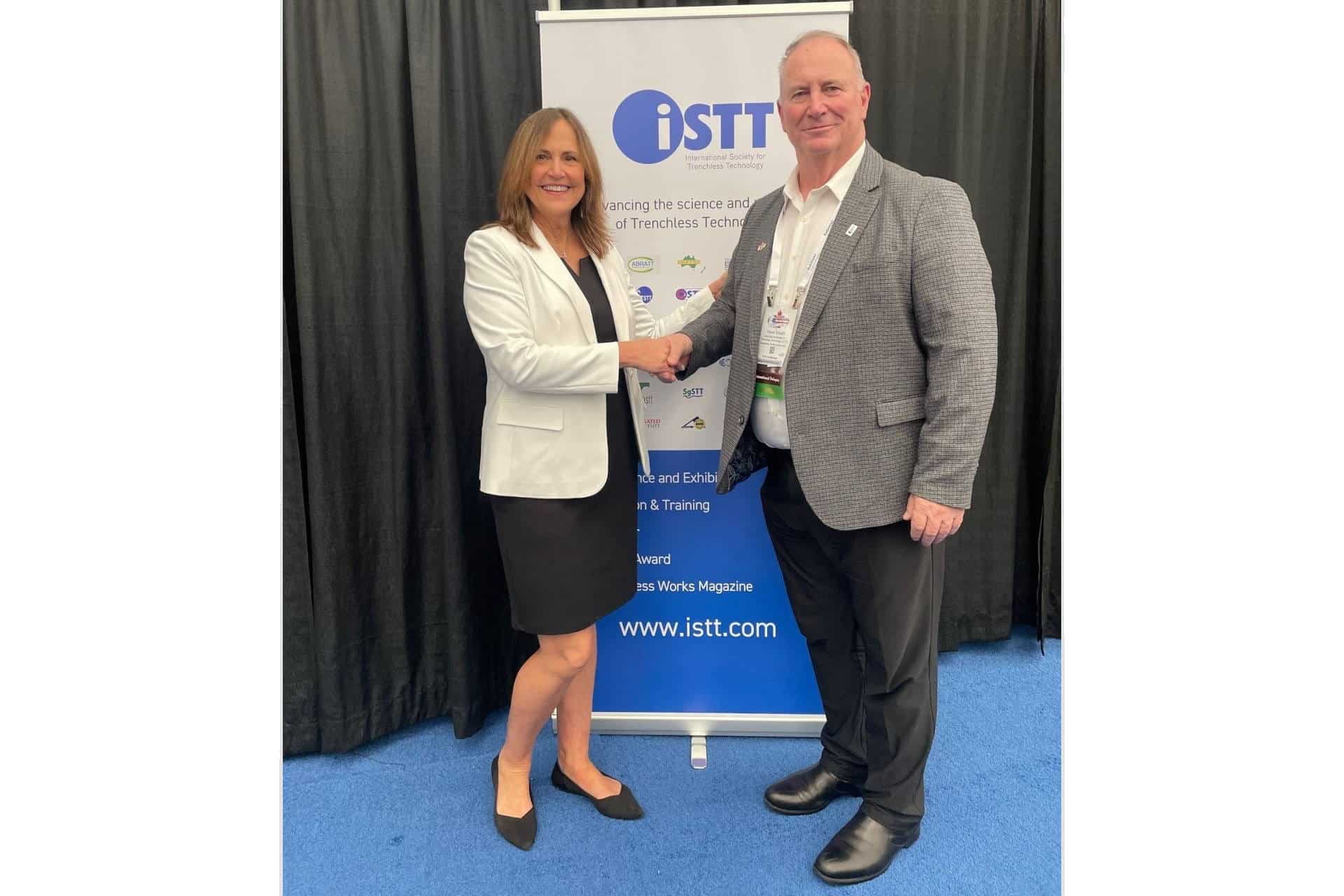Trenchless Acceptance Opens New Doors for Plowing Technology
 In the ISTT Update in the January/February 2006 issue of TrenchlessTechnology International, ISTT executive secretary John Castle reported onan Executive Sub Committee (ESC) meeting held Sept. 15, 2005, at which adecision was made to accept plowing technology, also known as cable plow or moleplow technology, as a trenchless technique.
In the ISTT Update in the January/February 2006 issue of TrenchlessTechnology International, ISTT executive secretary John Castle reported onan Executive Sub Committee (ESC) meeting held Sept. 15, 2005, at which adecision was made to accept plowing technology, also known as cable plow or moleplow technology, as a trenchless technique.This decision will allow plowing to run alongside the established techniques,such as microtunneling, horizontal directional drilling and pipeline renovationsystems, as a full member of the trenchless technology family.
In making its decision, the ESC considered that plowing met all the keybenefits of a trenchless system, in that it reduces environmental impact anddisruption, minimizes the need for excavation and, once completed, leaves littleevidence that the insertion of a pipe or cable has occurred at all. The ESC feltthe excavation of a trench is only for a short time, since it is closedimmediately after the pipe or cable has been laid, and the process does notinvolve any of the usual activities involved in open-cut, such as spoil removal,shoring, placement of bedding materials, etc.
What is Plowing?
Plowing is exactly whatit says on the packet: The system uses a specially designed plowshare, blade orlamella — you can choose which term you prefer — that is pulled through theground using a strong wire cable attached to a towing unit or a wheeled/trackedtowing unit. The blade runs through the ground at a pre-set depth to create atrench, exactly as it is done in farming. The main difference is that utilityinstallations need only a single trench, rather than many in a row and to a fargreater depth than is needed for agriculture.
The cable or pipe is laid immediately behind the plowing blade before thetrench has time to collapse or fill with soil. Filling the trench is not left tochance; a second blade on the plow is used to return the material, opened out ofthe trench by the first blade, to its original position so closing theexcavation.
This description is of course something of a simplification. Various optionsallow the system to be used to install trench bedding material if required andthe design of the system normally allows the weight of the plowing unit to beutilized to compact the base of the trench as it is opened. The product, be itcable or pipe, is normally supplied via reels that are moved along the route ofthe installation, connected to the plowing unit so that the product can be feddirectly into the ground through a feed mechanism on the plow body.
The technique is not generally as applicable to the tight urban spaces oftenassociated with trenchless techniques as it is more suited to open,cross-country situations. However, where grass or open soil verges of somelength exist in urban areas, it can be quite suitable, provided that otherservices are not likely to be disturbed by the plow.
The main advantage is that great distances can be achieved in a singleworking shift, with up to 5,000 m being completed in a single day in the rightcircumstances. This is well in excess of the tens of meters per day achievedusing more traditional open-cut techniques and even outstrips significantly theoften hundreds of meters per day of the more recognized trenchless systems likeHDD.
Plowing Example
In practical terms, itis probably easier to explain how plowing works by using an example. Germany’sEnergie Baden-Württemberg AG’s (EmBW),an electrical utility company based inNeckar — Franken needed to enhance its 20 kV cable network in the HohenloherRegion. A medium voltage cable bundle, comprising 3 x NA2XS2Y, 150 mm2 aluminiumcables, had to be installed over a total length of 6.5 km between the towns ofEschenhof and Hohenrot.
The new cables were required to improve the robustness of the network andalso to provide a ring structure and standby service supply line for a largecompany in the Hohenrot area. The work also provided an opportunity to installsome new 1 kV branch connections.
The contractor engaged for the main line cable plowing work was FöckerspergerGmbH of Aurachtal, supported by Benningern GmbH of Bad Mergentheim for all othercivil engineering works. Included in these other works were inspecting allutility service lines adjacent to the plowing route, any necessary excavationwork, production of starting pits for the cable plow operation and roadcrossings. The road crossings were carried out using trenchless techniquesutilizing a soil displacement hammer to install ND 125 protection ducts.
The remaining civil engineering work to reinstate surfaces and surroundings,such as in the town of Weldingsfelden where it was not possible to plow, werealso carried out by Benningern.
Föckersperger used a crew of three for the cable plow, a winch vehicle and aplowing system comprising a Unimog (a 4-wheel drive all terrain vehicle), cableplow and a cable trailer. The operation installed almost 5,000 m of mediumvoltage cable in just three working days, which included both assembly anddispersal of equipment from the worksite. The installation was achieved at aminimal set-up cost and included the installation of both the cable and abore-path warning tape.
The Plow Unit
The cable plow was a 17ton, F 150 Unimog unit. The unit has four wide rubber-tired wheels, to give lowground pressure loadings, which are attached to four adjustable booms that canbe hydraulically adjusted to accommodate any uneven terrain of up to ±1.5 mheight difference between two parallel running wheels. The system operates witha ground clearance of up to 1.7 m and has an adjustable track width of between 2and 6 m to enable the unit to steer around any obstacles. This configurationalso allows the vehicle to handle gradients of 1:1. The plow unit is towed by acable winch that is fitted to a multi-terrain, Unimog 240 horsepower winch unit,with a 100-ton pulling force.
The pulling cable was extended to lengths of between 75 and 100 m for eachadvance of the cable plow and was pulled forward at a moderate walking pace. Forwork in strongly rooted shallow ground, an 800-mm diameter, steel disc cuttingtool installed inside the front section of the cable plow could be lowered tocut near surface roots to reduce resistance to the plow.
To start the plowing run, the plow blade is lowered into a small start pit atthe required installation depth. The plow is then pulled forward by the winchcable, so that the plow blade, which has a wedge point in the direction oftravel, penetrates forward into the ground to create a cable installation void.The cable and path warning tape are then laid into this void through a movablecable shaft, which is attached to the plow unit so that both can be movedindependently of one another. This arrangement means that the blade and thecable shaft can always be guided independently, both horizontally and parallelto the ground surface, to insert the product at the required depth.
On the Hohenloher project, the ground was compact and slightly sandy withrocky inclusions in some areas. These conditions caused no serious problems forthe plow, which, due to its weight and size was stable and the 100-ton pullingforce, was more than adequate.
The concept of the winch-pulled cable plow proved to have further advantagesin this application. Because the forward movement is produced via the winch, notraction forces arise on the plow itself. This is not the case with self-drivencable plows because a soft ground surface can be seriously affected by drivingwheels or tracks. At Hohenloher, during each plowing section, only lightindentations from a stabilizing blade lowered by the winch unit, occurred on thesurface.
At Hohenloher, given that over a large stretch of the installation route theplow wheels were touching either the asphalt road on one side and/orsimultaneously touching higher ground on the other, there were no problems withwheel spin because no traction was applied through the plow wheels.
Föckersperger GmbH has been manufacturing pipe and cable plows and utilizingthem on a contract basis for more than 30 years. To date, the company, acting asa service company, has installed more than 50,000 km of cables and pipes usingits technology and works with more than 400 construction contractors acrossGermany, Austria, the Czech Republic, Hungary and Poland.
In summary, under the right conditions, plowing has several advantages andcan be extremely cost-effective. It causes low traffic disruption; there is nomixing of soils; there is almost no compaction and, like any good trenchlesstechnique, it offers good environmental compatibility and produces little grounddamage. It can offer up to 90 percent air pollution savings as compared to moretraditional open cut techniques.
Ian Clarke is a freelance writer and owner of No-Dig Media, based in theUnited Kingdom. The article was based on information provided by ISTT,Föckersperger GmbH and Tracto-Technik GmbH.




